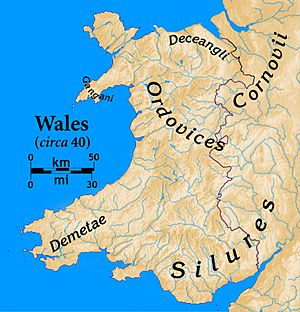Silures facts for kids
The Silures were a strong and brave group of people who lived in ancient Britain during the Iron Age. They lived in what is now south east Wales and some nearby areas. To their north were the Ordovices, to their east the Dobunni, and to their west the Demetae.
Contents
Who Were the Silures?
Their Appearance
The Roman writer Tacitus wrote about the Silures. He said they often had dark skin and curly hair. Because of this, Tacitus thought they might have come from Spain a long time ago.
Another writer, Jordanes, also described them. He said, "The Silures have swarthy features and are usually born with curly black hair." He compared them to people from Gaul (modern France) or Spain.
How They Lived
Archaeologists have found old forts on hills, like the one at Llanmelin near Caerwent. Some people thought these forts were the main centers for the Silures. However, most experts now believe the Silures were a group of smaller communities. These communities shared similar ways of life and beliefs.
Besides hillforts, there's also proof of roundhouses where people lived. These have been found in places like Gwehelog and Thornwell. There's also evidence of people living in lower areas, especially at Goldcliff.
What Does "Silures" Mean?
The name "Silures" comes from an old Celtic word. It might mean "seed" or "blood-stock." This could refer to the idea that the tribe believed they all came from the same ancient ancestor. One idea is that the name originally meant "rich in grain."
Brave Fight Against the Romans
The Silures were very brave and fought hard against the Roman Empire around AD 48. They got help from Caratacus, a strong leader from another tribe called the Catuvellauni. Caratacus had fled to Wales after his own people were defeated by the Romans.
Early Roman Attacks
The first Roman general to attack the Welsh tribes was Publius Ostorius Scapula. This was around AD 48. He first fought the Deceangli in northeast Wales. Then, he spent several years fighting the Silures and the Ordovices. Caratacus led the resistance. He first helped the Silures, then moved to the Ordovices' land. The Romans defeated him there in AD 51.
Guerrilla Warfare
Even after Caratacus was defeated, the Silures did not give up. They used clever guerrilla warfare tactics against the Roman soldiers. General Ostorius had even said that the Silures were so dangerous they should be wiped out or moved away. But his threats only made the Silures more determined to fight.
They surrounded and attacked a large group of Roman soldiers who were building forts. The Romans only escaped with great difficulty and many losses. The Silures also captured Roman soldiers. They then shared these prisoners among nearby tribes. This helped to unite the tribes and encourage them to keep fighting the Romans.
General Ostorius died without defeating the Silures. After he died, the Silures even defeated the Second Legion of the Roman army. It's not completely clear if the Romans ever truly defeated the Silures in battle. Some Roman writings suggest they eventually made peace with Sextus Julius Frontinus around AD 78. Tacitus, a Roman historian, wrote that the Silures "was changed neither by cruelty nor by clemency." This shows how determined they were.
Life Under Roman Rule
Roman Towns and Forts
To help control the area, the Romans built a large army base called Isca (later Caerleon) right in the middle of the Silures' land.
The town of Venta Silurum (Caerwent) was built in AD 75. It became a Roman-style town, with many Roman buildings. Its large Roman walls can still be seen today. Digs have shown it had a forum (a public square), a temple, baths, an amphitheatre, shops, and nice houses with mosaic floors.
Local Government and Culture
In the late 1st and early 2nd centuries, the Silures were given some freedom to manage their own local affairs. The Romans often linked their own gods with local gods. For example, the local Silurian god Ocelus was seen as the same as Mars, the Roman god of war.
Caerwent seems to have continued as an important religious place even after the Romans left. The land of the Silures later became the Welsh kingdoms of Gwent, Brycheiniog, and Gwynllŵg in the 5th century. Some stories about King Arthur suggest he might have been a leader in this area. There's good evidence that the culture of the Silures continued through the Roman period, especially into the kingdom of Gwent. Leaders in Gwent even used the name "Caradoc" to remember the British hero Caratacus.
The Word "Silurian" Today
Sometimes, you might hear the word "Silurian" used to talk about this time in Celtic history. The poet Henry Vaughan called himself a "Silurist" because he came from South Wales.
The geological period called the Silurian was named after the Silures. This is because the rocks from that period were first studied in the lands where the Silures lived. This period comes after the Cambrian and Ordovician periods, which are also named after places in ancient Wales.


